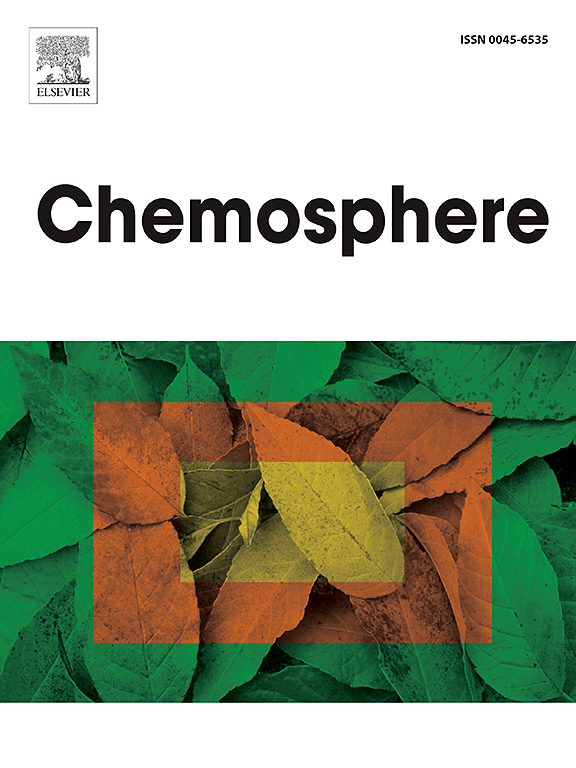Lead stress triggers the synthesis of protecting salicylic acid through polyamine accumulation in the Pb-resistant species Piptatherum miliaceum (L.) Cosson
IF 8.1
2区 环境科学与生态学
Q1 ENVIRONMENTAL SCIENCES
引用次数: 0
Abstract
To assess the impact of polyamines and salicylic acid on the response of Piptatherum miliaceum to lead toxicity, plants were cultivated in nutrient solution containing 500 μM Pb(NO3)2 in the presence or absence of polyamine synthesis inhibitors (d-Arginine 5 mM, cyclohexylammonium 5 mM, methylglyoxal-bis-guanyl-hydrazone 1 mM), ethylene synthesis inhibitor (2-aminoethoxyvinyl-glycine 2 μM) and/or exogenous supplementation of 100 μM putrescine, spermidine, spermine or 10 μM salicylic acid. Although all plants remained alive until the end of the treatment, Pb toxicity induced a decrease in growth and cell viability and an increase in electrolyte leakage. Plants accumulated up to 84.2 mg kg−1 DW Pb in the shoots and 901.6 mg kg−1 DW in the roots. Lead increased endogenous concentration of polyamines and salicylic acid. It increased phenylalanine ammonia lyase activity (PAL) in roots and shoots and isochorismate synthase activity (ICS) in shoots only. Glutathione increased in response to Pb, as well as root ascorbate and phytochelatins. All inhibitors of polyamines aggravated the deleterious impact of Pb on recorded parameters while simultaneous application of polyamines allowed to compensate this effect. Spermidine restricted root-to-shoot Pb translocation while ethylene increased Pb absorption and accumulation. Spermine stimulated ICS activity in the shoots but not in the roots, leading to high salicylic acid (SA) concentrations in photosynthetic tissues. Salicylic acid stimulated glutathione and phytochelatin synthesis in the roots. Hence, polyamines and SA play a role in Pb tolerance of P. miliaceum but act on distinct targets. These compounds exhibit specific interaction in Pb-stressed organs which differ between roots and shoots.

铅胁迫通过多胺积累触发耐铅物种水杨酸的合成Cosson
为了研究多胺和水杨酸对铅毒性反应的影响,将植物培养在含有500 μM Pb(NO3)2的营养液中,在存在或不存在多胺合成抑制剂(d-精氨酸5 mM、环己胺5 mM、甲基乙二醛-双鸟酰腙1 mM)、乙烯合成抑制剂(2-氨基乙氧基乙烯基甘氨酸2 μM)和/或外源添加100 μM腐胺、亚精胺、精胺或10 μM水杨酸的情况下进行培养。虽然所有植物在处理结束前都存活,但铅中毒导致植物生长和细胞活力下降,电解质泄漏增加。植株在茎部累积的Pb最高可达84.2 mg kg - 1 DW,根部累积的Pb最高可达901.6 mg kg - 1 DW。铅增加了内源性多胺和水杨酸浓度。仅提高了根和芽中苯丙氨酸解氨酶活性(PAL)和芽中异丙酸合成酶活性(ICS)。谷胱甘肽以及根抗坏血酸和植物螯合素对铅的响应增加。所有多胺抑制剂都加重了Pb对记录参数的有害影响,而同时应用多胺可以补偿这种影响。亚精胺限制了铅的根到茎的转运,乙烯则增加了铅的吸收和积累。精胺刺激了茎部而不是根部的ICS活性,导致光合组织中水杨酸(SA)浓度升高。水杨酸刺激了根内谷胱甘肽和植物螯合素的合成。由此可见,多胺和SA在百米草耐铅性中起一定作用,但作用靶点不同。这些化合物在不同于根和芽的铅胁迫器官中表现出特定的相互作用。
本文章由计算机程序翻译,如有差异,请以英文原文为准。
求助全文
约1分钟内获得全文
求助全文
来源期刊

Chemosphere
环境科学-环境科学
CiteScore
15.80
自引率
8.00%
发文量
4975
审稿时长
3.4 months
期刊介绍:
Chemosphere, being an international multidisciplinary journal, is dedicated to publishing original communications and review articles on chemicals in the environment. The scope covers a wide range of topics, including the identification, quantification, behavior, fate, toxicology, treatment, and remediation of chemicals in the bio-, hydro-, litho-, and atmosphere, ensuring the broad dissemination of research in this field.
 求助内容:
求助内容: 应助结果提醒方式:
应助结果提醒方式:


